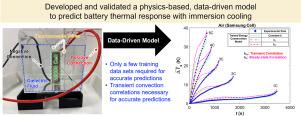A comprehensive fundamental study of static immersion cooling of Li-ion battery: Experiments to data-driven model
IF 5.8
2区 工程技术
Q1 ENGINEERING, MECHANICAL
International Journal of Heat and Mass Transfer
Pub Date : 2025-10-17
DOI:10.1016/j.ijheatmasstransfer.2025.127945
引用次数: 0
Abstract
Static immersion cooling (that is, immersing a hot object in a quiescent fluid) is an effective and straightforward thermal management approach useful for devices ranging from batteries to data centers. In the present work, we comprehensively evaluate static immersion cooling for lithium-ion batteries (LIBs), leveraging experimental measurements to inform data-driven models. We measure the evolution of cell voltage and temperature during discharging for three different LIBs (two commercial and one custom built with an internal thermocouple) with five different cooling fluids (four dielectric fluids and air) across various discharge rates (0.25C to 5C). While controlling temperature rises can improve safety (avoiding thermal runaway), lower temperature rise (i.e., better cooling) leads to higher heat generation rates and lower discharge time ( energy supplied) due to the electrochemical kinetics, and this thermally-driven apparent capacity fade becomes more significant at higher discharge rates. For example, at 5C, air cooling with a temperature rise of 53.7 K corresponds to a discharge time of 693 s and 12.5 W of heat generation, whereas cooling with deionized water yields a temperature rise of 7.6 K corresponds to a discharge time of 599 s and heat generation of 16.7 W. Moreover, the internal temperature gradient (i.e., temperature difference between the core and surface) of the cell is approximately independent of cooling fluid at low discharge rates (3 K for all fluids at 1.5C), even though the absolute magnitude of temperature rise is significantly different. Further, we propose techniques to estimate the internal heat generation rates and heat transfer coefficients from the measured data. Building on this, we develop physics-based data-driven models for temperature response during charging and discharging, thus eliminating the need for large training data sizes. One method leverages conservation of energy (with cell voltage as input) to model the evolution of temperature (with error less than 1 K). The second method introduces an electrochemical model to eliminate the need for cell voltage, resulting in error of less than 0.86 K in the temperature predictions. Finally, we show the influence of the choice of fluids on LIB degradation (early trend), demonstrating that there is an optimum window of temperatures to minimize the irreversible degradation of the batteries. Ultimately, these data-efficient models provide a tool for the quick design and real-time thermal control of immersion-cooled systems.

锂离子电池静态浸没冷却的综合基础研究:数据驱动模型实验
静态浸入式冷却(即将热物体浸入静止流体中)是一种有效而直接的热管理方法,适用于从电池到数据中心的各种设备。在目前的工作中,我们全面评估了锂离子电池(lib)的静态浸没冷却,利用实验测量来为数据驱动模型提供信息。我们测量了三种不同的lib(两种商用和一种内置热电偶的定制)在五种不同的冷却流体(四种介电流体和空气)在不同的放电速率(0.25C至5C)下放电期间电池电压和温度的演变。虽然控制温升可以提高安全性(避免热失控),但由于电化学动力学的原因,较低的温升(即更好的冷却)会导致更高的产热率和更短的放电时间(∝供能),并且这种热驱动的表观容量衰减在较高的放电率下变得更加显著。例如,在5C时,风冷升温53.7 K,对应的放电时间为693 s,发热量为12.5 W,而去离子水冷却升温7.6 K,对应的放电时间为599 s,发热量为16.7 W。此外,电池的内部温度梯度(即核心和表面之间的温差)在低放电速率下(所有液体在1.5℃下为~ 3 K)与冷却液大致无关,尽管温升的绝对幅度有显著差异。此外,我们提出了从测量数据估计内部热生成率和传热系数的技术。在此基础上,我们开发了基于物理的数据驱动模型,用于充电和放电过程中的温度响应,从而消除了对大型训练数据的需求。一种方法利用能量守恒(以电池电压为输入)来模拟温度的演变(误差小于1 K)。第二种方法引入了电化学模型来消除对电池电压的需求,导致温度预测误差小于0.86 K。最后,我们展示了液体选择对锂离子电池降解的影响(早期趋势),表明存在一个最佳温度窗口,以最大限度地减少电池的不可逆降解。最终,这些数据高效的模型为浸入式冷却系统的快速设计和实时热控制提供了工具。
本文章由计算机程序翻译,如有差异,请以英文原文为准。
求助全文
约1分钟内获得全文
求助全文
来源期刊
CiteScore
10.30
自引率
13.50%
发文量
1319
审稿时长
41 days
期刊介绍:
International Journal of Heat and Mass Transfer is the vehicle for the exchange of basic ideas in heat and mass transfer between research workers and engineers throughout the world. It focuses on both analytical and experimental research, with an emphasis on contributions which increase the basic understanding of transfer processes and their application to engineering problems.
Topics include:
-New methods of measuring and/or correlating transport-property data
-Energy engineering
-Environmental applications of heat and/or mass transfer

 求助内容:
求助内容: 应助结果提醒方式:
应助结果提醒方式:


